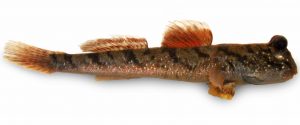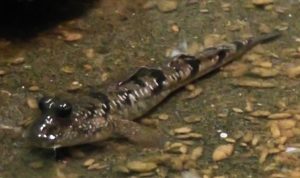The New Guinea mudskipper (Periophthalmus cantonensis, aka Periophthalmus novaeguineaensis) also known to tropical fish keeping enthusiasts as the New Guinea dyndspringe, is found in northern Australia, the Fly river delta in Papua New Guinea, and Merauke, New Guinea.
The New Guinea Mudskipper is found in freshwater streams, the marginal areas of estuaries and tidal creeks, as well as the brackish water mangrove and nipa palm areas of it’s range.
Periophthalmus cantonensis, aka Periophthalmus novaeguineaensis has a light brown background body color that blends into gray around the head, dorsal area, and flanks. The ventral area blends into a cream to whitish color, and there are 7 to 8 dark brown diagonal bars on the dorsal and flanks of the body that are saddle like in appearance. The areas between the bars often have blotches present.
The head, flanks, and body is speckled with iridescent sky blue and small reddish brown dots, and very often short vertical stripes. The fins are colored a translucent brown with darker reddish brown to black bands that are more evident on the dorsal and pelvic. The anal, pectoral, and caudal fins usually have no markings except for small brown spots or dusky pigmentation along the length of the fins.
Male New Guinea Mudskippers are more colorful and darker than the females with more heavily pigmented anal and pelvic fins.
New Guinea Mudskippers live among the mud banks of tidal creeks, tide pools, and inlets of their range and because they need to keep their bodies moist, they never venture very far from the water.
Although they are sometimes found in pure fresh water, they are more often found along the steep mud banks of tidally influenced rivers.
Like all mudskippers, the New Guinea Mudskippers is able to breathe air through it’s skin, and the lining of it’s mouth and throat. They are capable of “walking” on land using their modified pectoral and pelvic fins. When they are on land, their pectoral fins can be rotated around their central axes, which allows them to “drag” themselves along through the mud.
When they bend their tail forwards and off to one side, forming a sort of springboard, and quickly flex and release their tails; they have the unique ability to “skip” or jump across the mud, hence their name.
The eyes of the New Guinea Mudskipper are set high on their head, which gives them a 360° view of their domain. Their eyes give them a cute, inquisitive expression, and in aquarium environment they will often scoot close to the tank glass to see what is going on. They quickly learn to recognize their keepers when they see them outside of their tank, and are easily trained and actually seem to enjoy climbing onto the hand of their keeper to accept bits of food .
The New Guinea Mudskipper is best housed in at least a 30 gallon aquarium (for a single fish) with an exposed mud, fine gravel, or sandy substrate “beach”, some partially submerged driftwood or bogwood, a few rocks, and a tightly closed cover to replicate the humid conditions needed and prevent them from leaving their tank.
Groups of 5 or more should be housed in a much larger tank that provides them with enough room to set up individual territories. When crowded together, only one dominant individual will eventually remain.
New Guinea Mudskippers can be kept with small fiddler crabs, guppies, mollies, smaller killifish, flagfish, etc. of the same size, but smaller fish will be considered dinner. Avoid placing larger crabs that could eat the mudskippers in with them.
New Guinea Mudskippers do best in a brackish water environment with a specific gravity of about 1.005. Plants are not a necessity, but many tropical fish keeping enthusiasts like to use Java Fern (Microsorum pteropus), Rhizophora (mangrove) sp., or even boiled plastic plants for esthetics.
New Guinea Mudskippers are greedy and messy and although they can tolerate a wide range of water quality conditions, they are not particularly sensitive to accumulated wastes in the water.
The tank mates that they are usually housed with must have good water quality, therefore a good quality filtration system with regular water changes to eliminate nitrates, ammonia, and maintain the parameters necessary for the other species is paramount. Outside canister filters are highly recommended for these fish.
Because the natural environment of Periophthalmus cantonensis is almost impossible to replicate, they have never been successfully bred in an aquarium environment or even in public aquariums.
In their natural habitat, the males dig deep shafts into the mud where breeding and care of the young takes place. The eggs are deposited in the deepest chamber of the pit and where the female guards the young after they hatch out.
In the wild, New Guinea Mudskippers are opportunistic carnivores that feed on crabs, insects, worms, and other invertebrates. In an aquarium environment, they will eat live worms, crickets, flies, small pieces of seafood, meal worms, beetles, spiders, small fish, crustaceans, frozen bloodworms, mysis shrimp, brine shrimp, and even flake foods.
Because dried flake foods can swell up in the fish’s stomach and potentially cause bloating, they are not recommended. as a staple.
Although mudskippers are exported regularly from West Africa, Singapore, Vietnam, Thailand, India and Sri Lanka; Australian or New Guinean Mudskippers (Periophthalmus cantonensis, aka Periophthalmus novaeguineaensis) are almost impossible to ever find in tropical fish keeping shops or even on the Internet. Whenever they are available, they always demand a premium.
Minimum Tank Size: 30 gallons
Care Level: High
Temperament: Aggressive
Aquarium Hardiness: Hardy as adults
Water Conditions: 77.0 to 86.0° F, 10 – 25°H, pH 7.0-8.5
Salinity: 1.005 – 1.015
Max. Size: 3.15″
Color: Brown, Tan, Black, Blue
Tank Compatibility: single species
Diet: Omnivore (primarily Carnivore)
Origin: Australia, New Guinea
Family: Gobiidae
Lifespan: 6 years
Aquarist Experience Level: Advanced



